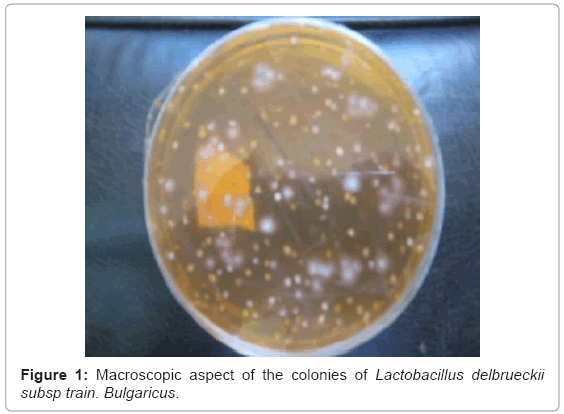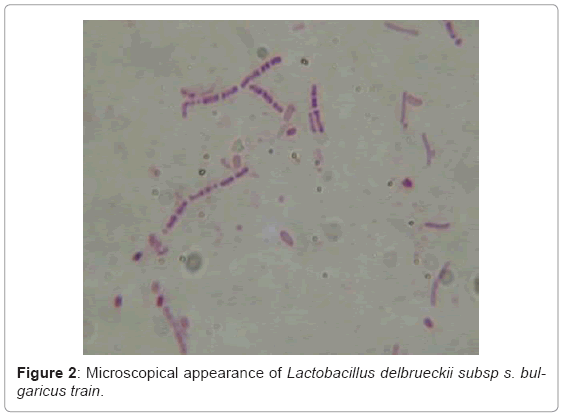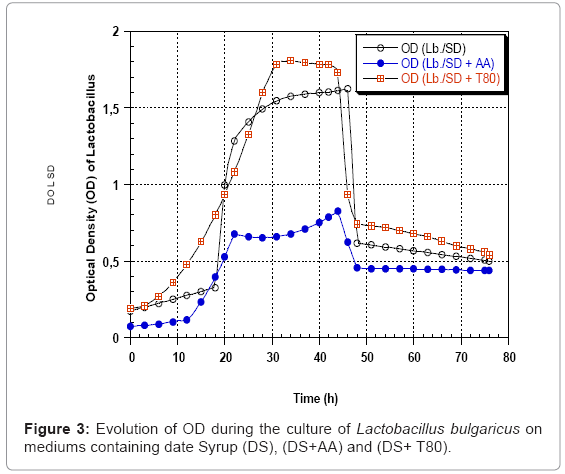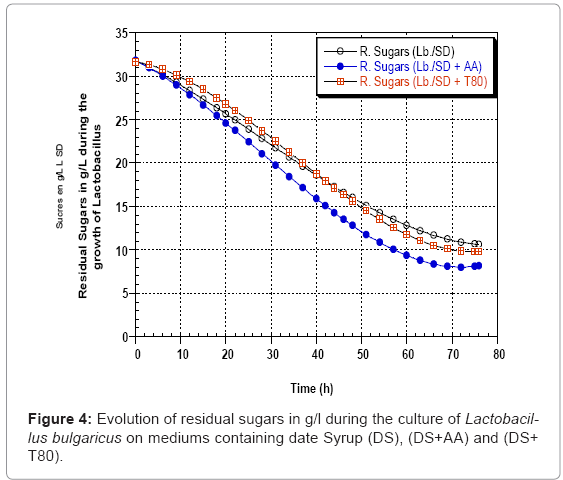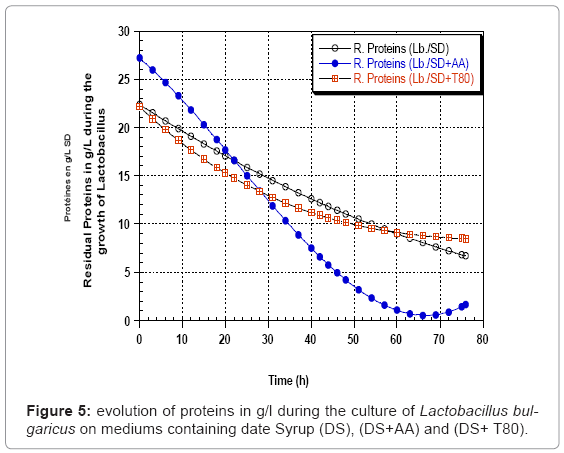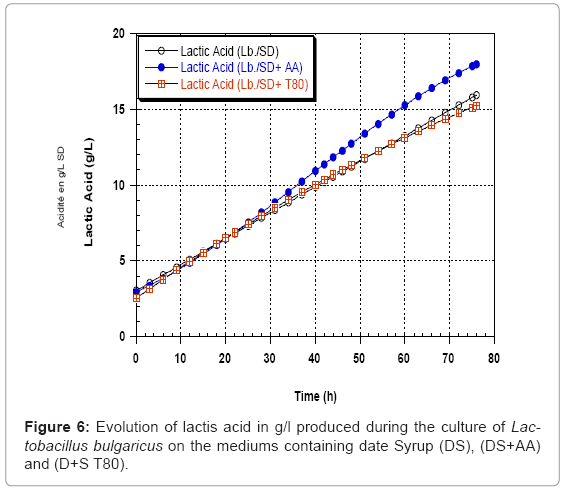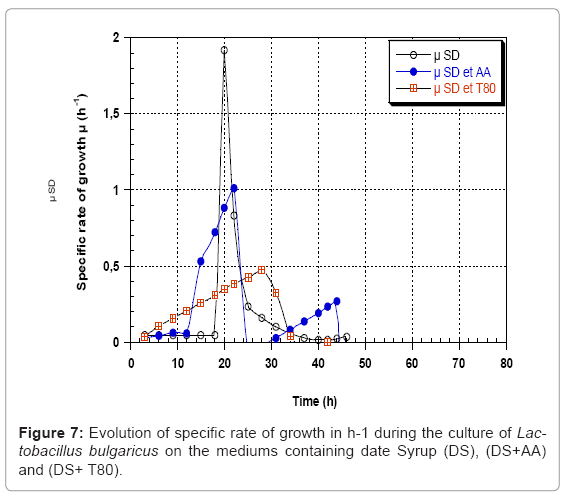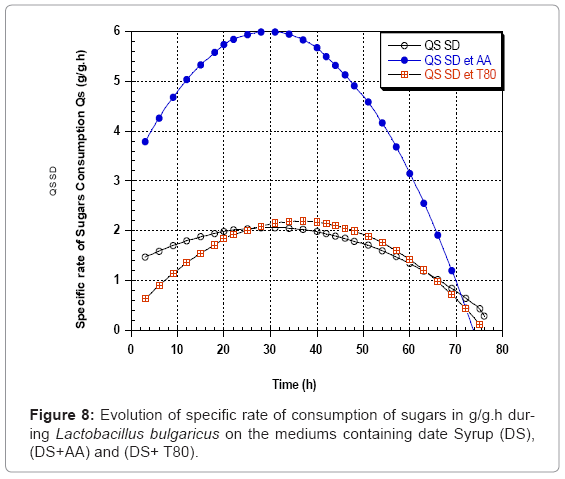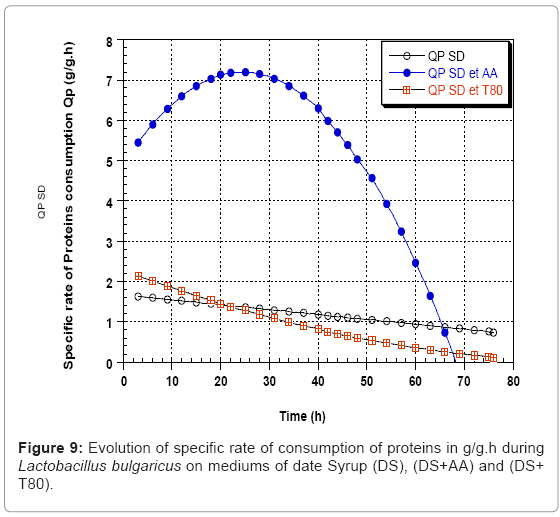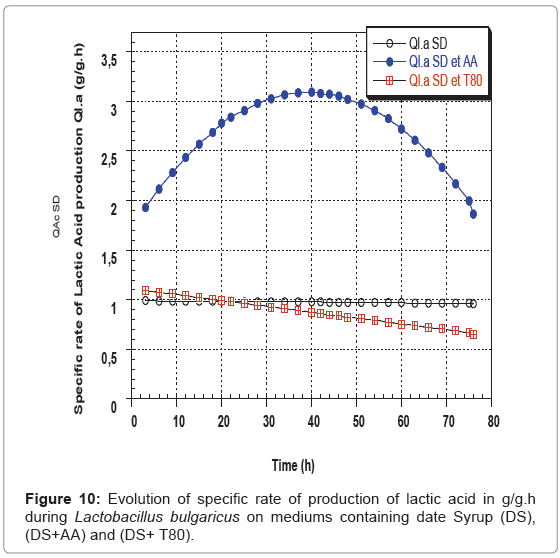Research Article Open Access
Study of the Behaviour of Lactobacillus Delbrueckii Subsp. Bulgaricus in Date Syrup in Batch Fermentation with Controlled pH
Bouhadi Djilali1*, Abbouni Bouziane2, Hariri Ahmed1, Ibri kada1 and Ouiss Nawal11Bioconversion Laboratory, Microbiology engineering and health Safety, Faculty of Science the Nature and Life, University of Mascara, BP.763, Sidi Said, Mascara, 29000, Algeria
2University of Sidi Bel-Abbès, Algeria
- Corresponding Author:
- Bouhadi Djilali
Bioconversion Laboratory
Microbiology engineering and health Safety
Faculty of Science the Nature and Life, University of Mascara
BP.763, Sidi Said, Mascara, 29000, Algeria
E-mail: bouhadidjilali@yahoo.fr
Received date: January 25, 2012; Accepted date: February 28, 2012; Published date: March 01, 2012
Citation: Djilali B, Bouziane A, Ahmed H, Kada I, Nawal O (2012) Study of the Behaviour of Lactobacillus Delbrueckii Subsp. Bulgaricus in Date Syrup in Batch Fermentation with Controlled pH. J Biotechnol Biomaterial 2:129. doi:10.4172/2155-952X.1000129
Copyright: © 2012 Djilali B, et al. This is an open-access article distributed under the terms of the Creative Commons Attribution License, which permits unrestricted use, distribution, and reproduction in any medium, provided the original author and source are credited.
Visit for more related articles at Journal of Biotechnology & Biomaterials
Abstract
Study of the use of date’s syrup like substrate a fermentation substrate for Acid lactic production gave as interesting results, the micro-organism implemented is kind Lactobacillus delbrueckii subsp. bulgaricus , cultivated in bathe fermentation. Three culture mediums were tested, the date syrup, date syrup enriched with amino acids and date syrup enriched with Tween80, the addition of the growth factors improve the culture, that is why the production of lactate is very important improved 24 g/l.
Keywords
Date syrup; Lactobacillus Delbrueckii Subsp. Bulgaricus; Fermentation; Lactic acid
Introduction
Dates are the subject of an important marketing activity, in particular the famous Deglet-Nour variety. This one holds the monopoly in national and international markets [1]. It profits even from certain marketing (presentation, packing etc). In parallel the other varieties known as common are less appreciated, less marketed and less competitive; they represent approximately 30% of the national production [2,3]. In contrast, they are very rich in nutriments (sugars, vitamins, minerals …, etc.) [1]. The waste and un-wanted materials usually issued from fermentation one being used to produce, protein, carbohydrate, and etc. in this current study, the palm used is less interesting in market, because these common varieties are hard, with a poor aspect and less attractive quality for the consumer. They’re used for animal alimentation [4].
The production of lactic acid by bacteria is really developed these years [5]. Lactic acid is an important material, because it is very used to produce many things like medicines, drinks, juice… etc [6]. Researchers intend to produce it by using different culture mediums [7,8]. An aim of the work consists of the use of date syrup as a substrate for Lactobacillus Delbrueckii Subsp. Bulgaricus, for the production of lactic acid.
Materials and Methods
Materials
Biologic material: The dates used in current experiments were of a variety half soft, known as Bechar badly exploited, cultivated in the area of Bechar (South-western of Algeria). The choice of this variety is justified by its availability and important nutritive value, especially the one of reducing fermentable sugars such as glucose and fructose. Its characteristics are given in Table 1.
| Parameters | Average volume |
|---|---|
| Weight of date (g) | 8.5 ± 0.76 |
| Weight of pulp (g) | 7.16 ± 0.93 |
| Weight of the stone (seed) (g) | 1.27 ± 0.18 |
| Length of date (cm) | 3.33 ± 0.16 |
| Width of date (cm) | 1.88 ± 0.41 |
| Length of the stone (seed) (cm) | 2.11 ± 0.19 |
| Width of the stone (seed) (cm) | 0.67 ± 0.34 |
Table 1: Morphological characteristics of the variety of Hamira date.
Leavens used: Lactobacillus Delbrueckii Subsp. Bulgaricus were obtained from Giplait of Mascara (Algeria). The strain of Lactobacillus is homo fermentative (homolactic) which means that more than 90% of metabolits are produced by the lactic fermentation. Among all the lactic bacteria the strain used has a highest growth rate (μmax) (1.0 to 1.4 h-1) and a shorter generation time (G), between (0.5 to 0.7 h), these two parameters improve the kinetics of growth and acidification [9].
Experimental protocol
The insulation of the lactic flora: The strain was inoculated at a rate of 1% in tubes containing 10 ml of sterile skimmed milk and incubated at 30°C until the coagulation of milk, then sown by streaking on MRS medium. The characterization of the strain isolated from MRS medium was carried out according to morphological, biochemical and physiological criteria [10].
The enrichment of Lactobacillus Delbrueckii Subsp. Bulgaricus was carried out using MRS broth.
Characterization and identification of the strain: The general characteristics that help differentiate strains of lactic acid bacteria are those advocated by several authors [11,12], it is study the cultural characters, morphological (macroscopic and microscopic), biochemical (fermentation type, hydrolysis esculin, acetonine production, research of hemolytic capacity, study of fermentative profit and research of arginine deiminase) and physiological (catalase, growth time and growth in adverse conditions). The identification is realized by comparing our result with data [10,13],
Preparation of date syrup: Dates are washed and destoned and grounded. Two and 1/2 litres of hot water at 80-85°C were added to I kg of date, homogenized and through a cloth. The syrup obtained was centrifuged at 15.000 rpm for 10 minutes to separate the cellulose debris. The collected supernatant was used as culture medium. The syrup is fixed in a pH between 6-6.5 and sterilized during 20 minutes at 120°C.
Conduction of the fermentation: The analysis applied on the date syrup shows that the syrup is not reached with amino acids and fattyacids, so the addition of these elements (growth factors) are necessary to the syrup in order to impure the quantity of lactic acid.
Three culture mediums are used.
1. Date syrup (DS)
2. Date syrup + Tween 80 (DS+ Tween 80)
3. Date syrup + amino acids (valin 1.5%, lysine 1.5%, aspartic acid 1.5% and methionine 1, 5%) (DS+ AA). (the amino acids are obtained separately from ALFA Aesar company, Germany)
Batch fermentation: Batch culture (discontinuous) was performed in Erlen of 250 ml with a working volume of 100 ml, inoculated in the presence of MRS medium incubated for 42°C for 24 h, similar cultures were equally conducted in a reactor having a capacity of five liters provided with all the accessories. The temperature of fermentation is maintained constant to 42°C and pH fixed at 6.2 by atomic addition NH4OH 5M (Development of Lactobacillus Delbrueckii Subsp. Bulgaricus recommends a pH between 5.8 and 6.5). Agitation is of 300 turns per minute.
The biomass evolution, sugar consumption and lactic acid production are followed at regular time intervals.
Analytical methods
Sugars were given according to the method of Dubois et al. [14]. The content of proteins was determined by the method of Kjeldahl according to Hamon et al. [11]. Concentration of the lactic acid was determined by acidity titration with NaOH [8]. The biomass was determined by measurement of the optical density (OD) at 600 nm.
Kinetic of growth: We take off every two hours until 28 hours 10 ml of medium of fermentation. We make a reading in a spectrophotometer to a length of wave 620 nm.
Lactic acid: Concentration of the lactic acid was determined by acidity titration with NaOH [13].
Data processing: The calculation of the kinetic parameters of fermentations has been performed using KALEIDAGRAPH software (Release 4.0.3 for windows, Synergy Software). This data processing is based on the technique of the averages slipping by using a polynomial of degree 2. The KALEIDAGRAPH software is a specific program for the graphs, the histograms and of statistical calculation, with this software we could;
• Determine experimental points for all the analytical analyzes
• Carry out a smoothing evolution of the experimental data.
• Trace the various graphs for the various parameters of fermentation
The various analyzes carried out allow following the evolution during the time of the concentrations of the components present in the culture medium:
[Biomass: X (OD) = f (t), sugars: S = f (t) and the metabolite produced (lactic acid): L = f (t) and proteins: P = f (t)].
X0, S0, P0, L0 represent the concentrations in biomass, in substrate and metabolites produced at time (t) of the fermentation. The slopes obtained starting from these lines represents respectively yield of conversion of sugars into biomass and lactic acid.
Results and Discussion
Identification of the lactic bacteria
The macroscopic observation indicates that the strain of Lactobacillus bulgaricus cultivated on solid MRS medium give colonies with size at least large, of regular contour and whitish in colour (Figure 1,2).
Physiological and biochemical tests (Table 2).
| Tests | Strains | Lactobacillus delbrueckii subsps. bulgaricus |
|---|---|---|
| Gram | + | |
| Catalase | - | |
| Growth à 15°C | - | |
| Growth 37°C | + | |
| Growth 45°C | + | |
| Growth pH 9.6 | - | |
| Growth at pH 3.4 | + | |
| Growth 4% Nacl | + | |
| Growth 6.5% Nacl | - | |
| Growth pH 9.6 | + | |
| Resistance at 60°C | + | |
| Resistance at 65°C | + | |
| Blue milk of Sherman | + | |
| Arginine deiminase | - | |
| Esculin | + | |
| Fermentative type | Homofermentative | |
| Levulose | - | |
| Glucose | + | |
| lactose | + | |
| Arabinose | - | |
| Sucrose | - | |
• (+): positive response
• (-): negative reaction
Table 2: Physiological and biochemical tests results of Lactobacillus bulgaricus.
Biochemical composition of syrup of dates
The date syrup obtained is very rich in sugars (31.82 g/l) and vitamin C (0.05 g/l), with a pH of 5.5; it seems to be favourable for the growth of Lactobacillus Delbrueckii Subsp. Bulgaricus. The date syrup is poor with amino acids and fatty-acids. An ash content of (2g/l) indicate its richness of minerals including potassium (271), sodium (145 mg/100 ml of MF), phosphorus (43 mg/100 ml of MF) and calcium (159 mg/100 ml of MF) and a very small amount of magnesium (0.33 mg/100 ml of MF) and manganese (0.21 mg/100 ml of MF).
Finally, the biochemical analysis of date syrup shows that it can constitute a fermentation medium of good quality.
Results of the fermentation kinetics
The results of the three fermentations, of the date syrup, date syrup enriched with amino acids and date syrup + Tween80 by Lactobacillus Delbrueckii Subsp. Bulgaricus are presented in figures 3-6, which present the evolution of the concentrations in biomass, sugars, proteins and lactic acid for the date syrup fermentation, we observe a weak initial concentration of biomass is of 0.2 then it increased after 36 h of fermentation until 1.6, after that we recorded the fall of biomass till a value of 0.5. In parallel, the production of the lactic acid starts from a value of 6 g/l and reach 17 g/l of lactate after 74 h of fermentation. During this fermentation which lasted 70 h the quantity of consumed sugars was 23 g. However for fermentation on medium containing date syrup with Tween80, the optical density of Lactobacillus Delbrueckii Subsp. Bulgaricus started with an initial concentration 0.2 to reach a maximum value of 1.8. This value was recorded after 30 h of fermentation then a decrease of the biomass up to a value of 0.5 was recorded. This decreasing in biomass correspond to the phase of decline which is due to the impoverishment of nutriments from the medium and the accumulation of metabolism wastes causing important physico chemical changes and bacteria lysis
For the production of lactic acid the culture of Lactobacillus Delbrueckii Subsp. Bulgaricus will reach the maximum of 15 g after 74 h of fermentation, in parallel and since there was an evolution of biomass and lactic acid, there was a consumption of sugars and proteins; it remained at the end of fermentation 10 g sugars and 8 g/l of proteins are left for the medium enriched by amino acids we observed a significant consumption of sugars 26.8 g/l and proteins 8.9. This great sugar consumption leads to the production of lactate which reaches a maximum value of 18 g/l after 74 h of fermentation. The comparison among three fermentations indicates that the addition of amino acids (nitrogen source) and Tween80 (fatty-acids) has a positive and very significant effect on the improvement of the quantity of lactic acid. Tween80 allows a better excretion of lactate by the cell by creating pores in the membrane. Tween80, mixture of oleic esters, is a source of fattyacids necessary to the growth of these germs. It is a growth factor; that ameliorate the speed of sugars assimilation by the lactic bacteria. The results achieved assimilate the result by [15].
The kinetic parameters of fermentation
The specific rate of growth (μ) in the medium of date syrup reached its maximum value (1.9 h-1) after 20 h of fermentation. In date syrup enriched with Tween80 rate (μ) was maximum after 28 h of fermentation while in the date syrup enriched by the amino acids it reached the maximum after 24 h (Figure 7), this means fast increase in the bacterial mass during fermentation, which is due to the consumption of the substrates that is very important during this phase (accelerating). Then, we notice a progressive reduction rate of growth of the bacteria, which can be due to bacterial lysis.
For the consumed sugar rate in DS+AA, we did note a maximum value of 6 g/g.h. A maximum value of 2 g/g.h for the other date syrup medium of dare syrup and date syrup with Tween80 (Figure 8).
Concerning specific rate of consumption of proteins (Qp) (Figure 9) we recorded for the medium which contains date syrup enriched by the amino-acids a maximum rate which is about 7.1 g/g.h. For the other cultures it (Qp) begins with a maximum rate from 2 g/g.h, then decrease with time up to the point of cancellation which corresponds to 74h of fermentation. For the date syrup culture we note a maximum rate of production of lactate (QAL) which was 3 g/g.h during 25 h of fermentation (Figure 10). For the other fermentations, the (QAL) post a maximum value of (1g/g.h). Superimposing and decreasing in the same time.
Conclusion
A culture medium can be defined like a support allowing the culture of the bacteria. They found in this medium, the necessary components for a fast growth and important production of biomass.
The results obtained confirm that the lactic bacteria are microorganisms more demanding from a nutritional point of view. Lactobacillus can produce until 18 g/l of lactic acid on medium containing date syrup with 32 g/100 ml of sugar and a maximum production of 24 g/l of lactic acid was reached after the addition of the amino acids and Tween80, this can be explained by the effect of the amino-acids added in date syrup which stimulates fermentation and cellular multiplication as well as the metabolic reactions. Tween80 has also a positive effect on the culture, since growth rate is improved, idem for the quantity of produced lactic acid, like for the quantity of consumed sugars which is more important with fermentation without addition of Tween80, this last plays a surfactant role which enhance the good contacts between the germs and the nutrients moreover Tween80 allows better excretion of lactate by the cell by creating pores in the membrane.
It would be interesting to look further into this study by optimizing other tests of enrichment such as the vitamins and cations for better adaptation of this natural environment to the nutritive needs for the lactic bacteria.
References
- Anonyme (1992) Transformation et Valorisation des Dattes et Sous-produits des Dattes', Symposium de la Datte, 24-25 nov Biskra.
- Anonyme (2001) Statistiques agricoles, Série A, superficies et production: M.A, D.S.A.E.E éd, Ministère de l'agriculture. Alger, Algérie 5-6.
- FAO (2008) Composition chimique des fruits des 15 cultivars tunisiens de palmier dattier Issue N°. Bioversity International 148: 19-25.
- Messar M (1996) Le secteur phoenicicole Algérien: Situation et perspectives à l'horizon 2010. Options méditerranéennes, série n° 28, séminaire méditerranéens, CIHEM et Estacion phonix 23-44.
- Heriban V, Sturdik E, Zalibera L , Matus P (1993) Process and Metabolic Characteristics of Bacillus Coagulans as a Lactic Acid Producer. Appl Microbiol 16: 243-246.
- Aeshchlimann A, Stockar U (1990) The effect of Yeast extract supplementation on the production of lactic acid from whey permeate by Lactobacillus helveticus. Appl Microbiol Biotechnol 32: 398-402.
- Hujanen M, Linko YY (1996) Effect of temperature and various nitrogen sources on L (+) Lactic Acid production by Latobacillus casei. Appl Microbiol Biotechnol 45: 307-413.
- Bernnan NM, Brown F, Ward M, Goodfellow M, Beresford TP (2001) P F Fox et M. Gogan, les bactéries lactiques. Int J Syst Evol Microbiol 51: 843-852.
- Guiraud JP (2003) Microbiologie alimentaire. edn. Dunod, Paris.
- Novel G (1993) Les bactéries lactiques in "Microbiolgie industrielle" Les microorganism d'intérêt industrielle. Ed. Techniques et documentation. Lavoisier, Paris 171-215.
- Hamon M, Pellerin F, Guenet M, Maauzie G (1990) Abrégés chimie analytique. Méthodes spectrales et analyse organique. Tome 3. 2ème edition, Masson, Paris 232-233.
- Audigie CL, Fagerella J, Zonszain F (1984) Manupulation d'analyse biochimique. Edition Tec et Doc. Lavoisier. Paris 270.
- Nancib A, Boudjelal A (2001) Production de l'acid lactique par Lactobacillus rhamnosus sur milieu à base de jus de dattes. Rev Energ Ren 41-46.
- Dubois M, Gilles KA, Hamilaton JK, Rebers PA, Smith F (1956) Colorimetric Method for Determination of Sugars and Related Substances. Anal Chem 28: 350-356.
- Hossain M, Brooks JD, Maddox JS (1985) Galactose Inhibition of Citric Acid Production from Glucose by Aspergillus niger. App Microbiol Biotechnol 22: 98-102.
Relevant Topics
- Agricultural biotechnology
- Animal biotechnology
- Applied Biotechnology
- Biocatalysis
- Biofabrication
- Biomaterial implants
- Biomaterial-Based Drug Delivery Systems
- Bioprinting of Tissue Constructs
- Biotechnology applications
- Cardiovascular biomaterials
- CRISPR-Cas9 in Biotechnology
- Nano biotechnology
- Smart Biomaterials
- White/industrial biotechnology
Recommended Journals
Article Tools
Article Usage
- Total views: 18467
- [From(publication date):
February-2012 - Dec 09, 2025] - Breakdown by view type
- HTML page views : 13545
- PDF downloads : 4922

